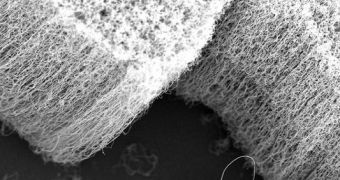Reproducing the functions of neurons is impossible without the creation of inter-neural links called synapses. Recently, experts in the United States announced the creation of the first artificial synapses, in an advancement that could lead to the development of the first synthetic brain.
In order to obtain the artificial link, the team used carbon nanotubes. Nanotechnology is shaping up to be one of the main contributors in the quest to obtain this advanced construct, analysts explain.
Building a synapse is very complex because the structure is, in fact, an empty space. It lies where two neurons nearly touch each other, and represents a medium through which small synaptic vesicles carry chemicals called neurotransmitters from one nerve cell to the next one.
The main role synapses play is to connect a single neuron with up to 10,000 others, and to allow for an electrical signal to pass through a chain of nerve cells called a neural pathway. Such chains are used by the brain to control muscles and automated process that go on inside the body.
Experts at the University of Southern California are among scientists who have been trying to emulate this ability the human body has in an artificial environment. By combining circuit design with nanotechnology, they finally managed to make headway in this area of research.
The work was conducted by experts with the USC Viterbi School of Engineering Ming Hsieh Department of Electrical Engineering, who were led by professors Chongwu Zhou and Alice Parker, Science News reports.
This achievement was detailed in the proceedings of the IEEE/NIH 2011 Life Science Systems and Applications Workshop, which was held on April 12. The team explains that CNT are usually added to electronic circuits, due to their ability to act as metallic conductors or semiconductors.
“This is a necessary first step in the process. We wanted to answer the question: Can you build a circuit that would act like a neuron? The next step is even more complex,” Parker explains.
“How can we build structures out of these circuits that mimic the function of the brain, which has 100 billion neurons and 10,000 synapses per neuron?” she goes on to say.
Despite the new advancement, producing an actual artificial brain is still decades away. But experts are taking things slow, focusing on one thing at a time. The next target for research is obtaining plasticity, the ability the brain has to remodel its neural pathways depending on external stimuli.
“The interdisciplinary approach is the only approach that will lead to a solution. We need more than one type of engineer working on this solution. We should constantly be in search of new technologies to solve this problem,” adds USC PhD student Jonathan Joshi.

 14 DAY TRIAL //
14 DAY TRIAL //